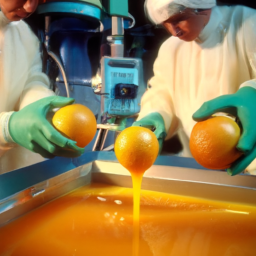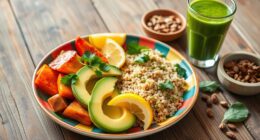Did you know that every year, Americans consume over 1.5 billion gallons of orange juice? That’s a lot of oranges! But have you ever wondered how many oranges it takes to make just one gallon of orange juice?
As a professional juicer, I am here to break down the factors that affect the amount of oranges needed and provide tips for juicing the perfect glass of orange juice.
Firstly, the amount of oranges required for a gallon of orange juice depends on a variety of factors, such as the juicing method, the size and ripeness of the oranges, and the desired sweetness and acidity levels.
Additionally, the juicing process can be quite wasteful, with up to 50% of the fruit being discarded as pulp and peel. But fear not, with a bit of estimation and some quality oranges, you can easily whip up a delicious and nutritious glass of orange juice in no time.
So let’s dive into the nitty-gritty of orange juicing and figure out just how many oranges are in a gallon of orange juice.
Key Takeaways
- Factors that affect the number of oranges needed for a gallon of juice include juicing method, orange size and ripeness, and desired sweetness and acidity levels.
- Up to 50% of fruit can be discarded as pulp and peel during juicing.
- Choosing the right variety and sourcing fresh, high-quality oranges is essential for taste and nutritional value.
- Estimating the number of oranges needed for a gallon of juice can be done based on average yield per orange, but actual results may vary depending on juicer used and orange ripeness.
The Factors that Affect the Amount of Oranges Needed
Let’s talk about the factors that affect how many oranges you gotta squeeze to make a gallon of OJ. There are several factors that can affect the yield of orange juice from a given number of oranges.
One of the most important is the ripeness of the oranges. Ripe oranges are easier to juice and have more juice than unripe ones. Another factor is the variety of the oranges. Some varieties are juicier than others, so you’ll get more juice from the same number of oranges.
Juicing efficiency is another factor that affects the amount of oranges needed to make a gallon of orange juice. This refers to how much juice you can extract from each orange. If you’re using a manual juicer, for example, you may not be able to extract as much juice as you would with an electric one. The type of juicer you use also matters. Centrifugal juicers are generally less efficient than masticating ones.
Understanding these factors can help you make the most of your oranges and get the most juice possible.
With this in mind, let’s move on to understanding the juicing process and how to get the best results.
Understanding the Juicing Process
Squeezing the life out of a fruit can be compared to wringing a sponge dry, revealing the sweet nectar hidden within.
Juice extraction methods influence the yield of juice from oranges. The most common type of juicing method is the centrifugal juicer. This method uses a spinning blade to shred the fruit into pulp and then separates the pulp from the juice through a strainer.
Another juicing method is the masticating juicer, which uses a slow and steady grinding process to extract the juice with minimal heat and oxidation.
When it comes to choosing the right type of oranges for juicing, the most popular varieties are Valencia and Navel oranges. Valencia oranges are known for their sweet flavor and high juice content, while Navel oranges are recognized for their easy-to-peel skin and low acidity.
It’s also important to note that organic oranges are preferred for juicing, as they’re not treated with pesticides that can harm the juicing process and the quality of the juice.
Understanding the juicing process and selecting the right type of oranges for juicing are crucial in determining the amount of oranges needed for a gallon of orange juice. With this knowledge in mind, let’s move on to estimating the amount of oranges needed.
Estimating the Amount of Oranges Needed
To estimate how much fresh, delicious juice you can make, it’s important to consider a few key factors. First and foremost, you’ll need to determine the amount of oranges required to make a gallon of juice. The most accurate way to do this is to measure the volume of juice produced by a set number of oranges. However, this can be time-consuming and impractical for most home juicers. Instead, you can estimate the number of oranges needed based on the average amount of juice produced by each fruit.
To do this, you can use the following table as a guide:
| Orange size | Average juice yield per orange |
|---|---|
| Small | 2-3 ounces |
| Medium | 3-4 ounces |
| Large | 4-5 ounces |
| Extra large | 5-6 ounces |
| Jumbo | 6-7 ounces |
Keep in mind that these measurements are only estimates and your actual results may vary depending on the juicer used and the ripeness of the oranges. To ensure estimating accuracy, it’s recommended to adjust measurements based on your individual results. With this in mind, you can confidently calculate the number of oranges needed to make a gallon of juice and start juicing!
Moving forward, it’s important to understand the importance of quality oranges in producing the best-tasting juice.
The Importance of Quality Oranges
When you want a glass of sunshine in a cup, choosing the right oranges is key. The quality of the oranges you choose will directly impact the taste and nutritional value of your orange juice.
When selecting oranges for juicing, it’s important to consider factors such as the variety and sourcing. Different orange varieties have varying levels of sweetness, acidity, and juiciness. For example, Valencia oranges are known for their sweet taste and high juice content, while Navel oranges have a lower acidity level. When choosing oranges for juicing, it’s important to choose a variety that suits your taste preferences and desired level of sweetness.
Additionally, it’s important to source oranges that are fresh and free from blemishes or bruises. Proper storage and shelf life are also important considerations to ensure the highest quality juice possible.
When selecting oranges for juicing, choosing the right variety and sourcing fresh, high-quality oranges is essential.
In the next section, we’ll explore some tips for juicing oranges to help you get the most out of your fruit.
Tips for Juicing Oranges
When I juice oranges, I always make sure to use the right equipment. A citrus juicer is the best choice for maximum juice yield and minimal waste.
Before juicing, it’s important to prepare the oranges by washing them thoroughly and bringing them to room temperature.
By following these steps, you can ensure that you get the most juice out of your oranges.
Using the Right Equipment
Making fresh orange juice with the right equipment is a game-changer, you won’t believe how much better it tastes! When it comes to choosing juicers, there are two main types to consider: centrifugal and masticating.
Centrifugal juicers are the most common and affordable option, but they tend to produce a lot of foam and heat, which can affect the flavor and nutrient content of the juice. Masticating juicers, on the other hand, use a slower, more gentle process that helps preserve the natural enzymes and vitamins in the juice.
Once you’ve chosen your juicer, it’s important to clean it thoroughly after each use to prevent bacteria buildup and ensure that your juice stays fresh and healthy. Most juicers come with a cleaning brush and instructions for disassembling and washing the different parts, but you can also find helpful videos and tutorials online.
With a little practice and attention to detail, maintaining your juicing equipment will become second nature, and you’ll be able to enjoy delicious, nutrient-rich orange juice any time you want.
When it comes to preparing oranges for juicing, there are a few key steps to keep in mind. First, choose ripe, juicy oranges that feel heavy for their size and have a firm, smooth skin. Wash them thoroughly with water and a small amount of vinegar to remove any dirt or pesticides.
Then, use a sharp knife or citrus peeler to remove the outer layer of skin and the white pith, which can be bitter and tough. Finally, cut the oranges into quarters or eighths and feed them into your juicer, making sure to discard any seeds or tough membranes.
With these simple techniques, you’ll be able to extract the maximum amount of juice and flavor from your oranges, and create a delicious, healthy beverage that’s sure to impress!
Preparing Oranges for Juicing
Preparing oranges for juicing is a breeze with a sharp knife and a little bit of practice – you’ll feel like a professional chef in no time!
The first step is to choose ripe oranges. They should be firm, heavy for their size, and have smooth, unblemished skin. Avoid any oranges that are soft, moldy, or have brown spots as they’re likely overripe or spoiled.
Once you’ve selected your oranges, the next step is to clean them before juicing. Rinse them under cold water to remove any dirt or debris on the skin. Use a vegetable brush to gently scrub the skin to remove any wax or pesticides that may be present. Dry the oranges with a clean towel before cutting them in half and squeezing out the juice.
By taking these simple steps, you can ensure that your juice is fresh, flavorful, and free from any unwanted contaminants.
To maximize juice yield, it’s important to extract as much juice as possible from each orange. One way to do this is by rolling the oranges on a hard surface before cutting them in half. This releases the juice from the pulp and makes it easier to extract.
Another tip is to use a citrus juicer or hand-held reamer to squeeze out the juice. These tools are designed to extract the maximum amount of juice from each orange and can help you get the most out of your fruit.
Maximizing Juice Yield
To get the most out of your citrus, it’s essential to extract every last drop of juice by using a citrus juicer or hand-held reamer. Juice extraction is a key step in maximizing your yield, and it’s important to choose the right tool for the job.
A citrus juicer is a great option for those who want to extract the maximum amount of juice with minimal effort. These machines work by squeezing the fruit between two cones, extracting the juice and leaving behind the pulp. Pulp removal is also an important consideration when trying to maximize your juice yield.
The pulp can contribute to a bitter taste and can also clog the machine, reducing the amount of juice that can be extracted. To remove pulp, simply strain the juice through a fine-mesh strainer or cheesecloth.
With these techniques, you can be sure to get the most out of your oranges and other citrus fruits. Other considerations, such as fruit quality and ripeness, will also play a role in your final juice yield.
Other Considerations
When it comes to calculating the number of oranges in a gallon of orange juice, it’s important to keep in mind the various factors that can affect the yield. One of these factors is the ripeness of the fruit. Over-ripe oranges may yield less juice than those that are just ripe, as the flesh can become too soft and the juice can start to ferment. On the other hand, under-ripe oranges may not yield as much juice because they haven’t fully developed their sugar content.
Another factor to consider is the efficiency of juicing. Some juicers may be more effective than others at extracting juice from the fruit, resulting in a higher yield. It can be frustrating to spend money on a large quantity of oranges only to end up with a small amount of juice. The disappointment of not being able to enjoy a refreshing glass of freshly squeezed orange juice can be disheartening. Additionally, improper storage options can also affect the yield of juice, as oranges that are stored at too cold of a temperature can become dry and difficult to juice.
When considering the nutritional benefits of orange juice, it’s important to note that fresh-squeezed juice contains higher levels of vitamins and minerals than store-bought juice. However, there are alternatives to fresh orange juice that can still provide similar nutritional benefits, such as frozen orange juice concentrate or pasteurized juice. These options may not have the same fresh taste as freshly squeezed juice, but they can still be a convenient and nutritious option.
Alternatives to Fresh Orange Juice
If you’re looking for a convenient way to get your daily dose of vitamin C, there are alternatives to fresh orange juice. One option is frozen orange juice concentrate, which is made by removing the water from fresh orange juice and freezing the concentrated juice. It can be stored in the freezer for several months and when you’re ready to use it, simply mix it with water according to the instructions on the package.
Another option is pasteurized juice, which has been heated to kill any bacteria and then packaged in a way that makes it shelf stable for several months. Juice blends are another option to consider. While orange juice on its own is a great source of vitamin C, blending it with other fruits and vegetables can add additional nutrients and flavor.
Additionally, there are many shelf stable options available that combine orange juice with other fruits and vegetables, making it easy to get a variety of nutrients in one convenient package.
Now that we’ve explored some alternatives to fresh orange juice, let’s move on to some recipes and serving suggestions.
Recipes and Serving Suggestions
Get creative with your vitamin C intake by trying out some of these delicious recipes and serving suggestions! If you’re looking for a refreshing drink on a hot summer day, head to your local juice bar and order a tall glass of freshly squeezed orange juice.
Not only is it a great source of vitamin C, but it’s also a tasty way to hydrate. Or, if you’re feeling adventurous, try making your own orange juice at home using a juicer or citrus press.
For those who prefer a little kick in their drinks, there are plenty of cocktail recipes that incorporate orange juice as a key ingredient. From classic screwdrivers to trendy Aperol spritzes, orange juice adds a bright and citrusy flavor to any cocktail.
So, next time you’re hosting a party or just want to treat yourself to a tasty drink, consider adding orange juice to the mix. And speaking of mix, did you know that oranges were originally a hybrid fruit of pomelos and mandarins?
Learn more fun facts about oranges in the next section!
Fun Facts About Oranges
I find it fascinating to explore the many facets of oranges beyond their recipes and serving suggestions.
Did you know that oranges were first cultivated in Southeast Asia?
They spread across the world through trading and colonization, becoming a popular fruit in many cultures.
Oranges are also packed with health benefits, including high levels of vitamin C and antioxidants.
And, aside from consuming them as a fruit or juice, oranges have many other uses, such as in essential oils and cleaning products.
History and Origin of Oranges
The sweet aroma of freshly picked oranges fills the air as we delve into the history and origin of this citrus fruit. Oranges were first cultivated in China over 4,000 years ago and were brought to the Mediterranean region by traders in the 15th century. Today, oranges are grown in over 140 countries, with the top producers being Brazil, the United States, and Mexico.
Oranges have played a significant role in many cultures throughout history. In ancient Greek mythology, the golden apples of the Hesperides were said to be oranges, symbolizing fertility and prosperity. Oranges were also highly valued by the Romans, who brought them to Britain in the 1st century AD. In many cultures, oranges are associated with good luck, happiness, and prosperity. It’s no wonder that oranges have become a cultural icon, with their bright color and sweet, tangy flavor. Moving on to the next section, let’s explore the health benefits of oranges.
Health Benefits of Oranges
Did you know that oranges are packed with essential nutrients that can help keep you healthy? Oranges are a great source of vitamin C, which is an antioxidant that helps protect your cells from damage. In fact, just one medium-sized orange contains over 100% of your recommended daily intake of vitamin C!
Oranges also contain other important vitamins and minerals, such as vitamin A, potassium, and folate. But, it’s important to note that some people may have citrus allergies, which can cause adverse reactions when consuming oranges or other citrus fruits. Additionally, while oranges are a healthy food choice, they should be consumed in moderation as they’re high in natural sugars.
Overall, oranges are a delicious and nutritious fruit that can be enjoyed in a variety of ways. Moving on to other uses for oranges, did you know that the essential oil from oranges is often used in aromatherapy? It’s believed to have a calming effect and can help reduce stress and anxiety.
Oranges can also be used in baking or cooking to add flavor and sweetness to dishes. Additionally, orange peels can be dried and used in tea blends or as a natural air freshener.
Other Uses for Oranges
You might be surprised to discover the versatile ways in which oranges can be used beyond just eating them as a fruit.
One of the most popular ways to use oranges is by making orange juice. With the right juicing techniques, you can extract every last drop of juice from the fruit, resulting in a sweet and tangy beverage that’s packed with vitamin C and other essential nutrients.
When it comes to making orange juice, the type of orange you choose can make a big difference in the flavor and nutritional content. Some of the most popular orange varieties for juicing include Valencia, Navel, and Blood Oranges.
Valencia oranges are known for their sweet and slightly tart flavor, while Navel oranges have a sweeter taste and are seedless. Blood oranges, on the other hand, have a more complex flavor profile and are rich in antioxidants.
Whether you prefer your orange juice sweet or tangy, there’s an orange variety out there that’s perfect for your juicing needs.
Frequently Asked Questions
What is the nutritional value of oranges?
Oranges are rich in vitamin C, which supports a healthy immune system. Drinking orange juice as a pre workout drink can also help improve endurance and reduce muscle soreness. Studies show that regular consumption of oranges can lower the risk of chronic diseases.
How long does it take to juice a gallon of oranges?
I can juice a gallon of oranges in about 30 minutes using high-efficiency juicing equipment. Juicing efficiency can vary based on the type of equipment used and the size and ripeness of the oranges.
Can other fruits be added to orange juice?
Mixing fruits in orange juice is like creating a symphony of flavors. Blending fruits adds variety and boosts nutritional value. Benefits of blends include increased antioxidants, vitamins, and minerals. Precision in measuring amounts of each fruit is crucial for technical success.
What is the best way to store freshly squeezed orange juice?
When storing freshly squeezed orange juice, glass bottles are preferable to plastic containers. Freezing can preserve its quality, but it can alter the flavor. Store in the refrigerator at 35-40°F and consume within 3-4 days for optimal freshness.
How does the acidity of oranges affect the taste of the juice?
As an acidic fruit, oranges impart a tangy flavor profile to their juice. The high vitamin C content of oranges provides numerous health benefits. The acidity of oranges can also affect the stability and shelf life of the juice.
Conclusion
In conclusion, juicing oranges is a simple process that requires a little bit of practice and patience. The amount of oranges needed to make a gallon of orange juice depends on various factors such as the size of the oranges, the type of juicer used, and personal preferences. However, on average, it takes approximately 14 to 16 oranges to make a gallon of orange juice.
It’s important to note that the quality of oranges used greatly affects the taste and nutritional value of the juice. Therefore, it’s recommended to use fresh, organic oranges that are free from any chemicals or pesticides. The fresher the oranges, the better the juice will taste.
As the saying goes, "you reap what you sow."The effort put into juicing oranges will yield a refreshing and nutritious drink that will leave you feeling energized and satisfied. So go ahead and grab a bag of oranges and start juicing your way to better health.
Hi, I’m Alexander. I’m a vegan of over 20 years, and I initially made the switch for health reasons. However, as time went on, I became more and more passionate about the ethical and environmental implications of leading a vegan lifestyle.
I am the author of The Graceful Kitchen, a vegan blog where I share recipes for delicious and nutritious vegan meals. As someone who is deeply committed to living a cruelty-free life, I am also a strong advocate for using whole foods as the foundation of a healthy diet – and believe that going vegan is one of the best ways to achieve this.
















